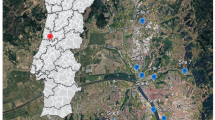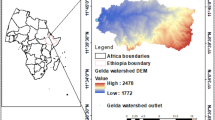Abstract
Channelization of alluvial systems alters the functions and processes of floodplain ecosystems. In the loess belt region of western Tennessee and northern Mississippi, channelization, the geology of the region, and past land-use practices have resulted in geomorphic readjustments of streams and the formation of valley plugs. Valley plugs completely block stream channels with sediment and debris, and can result in greater deposition rates on floodplain surfaces. We used dendrogeomorphic techniques to quantify floodplain sediment deposition rates from the last 100+ years. The data were used to determine the spatial and temporal patterns of sedimentation in floodplains affected by channelization and the subsequent formation of valley plugs and in floodplains along unchannelized streams. We measured sediment accumulation by coring trees for age determination and measuring depth to the root collar of 63 trees at unchannelized sites and 214 trees at channelized valley plug sites. Mean floodplain deposition rates were greater at valley plug sites (-x = 1.71 ± 0.08 cm/yr) compared to rates at unchannelized sites (-x = 0.31 ± 0.02 cm/yr). The formation of valley plugs in channelized streams also affected the spatial and temporal patterns of sedimentation. Increases in deposition rates at the valley plug sites occurred approximately 30 years ago and corresponds to the timing of regional activities including: channelization projects, increases in agricultural activity, and the termination of stream dredging projects.
Similar content being viewed by others
Literature Cited
Asselman, N. E. M. and H. Middelkoop. 1998. Temporal variability of contemporary floodplain sedimentation in the Rhine-Meuse Delta, The Netherlands. Earth Surface Processes and Landforms 23: 595–609.
Barbujani, G. 1988. Detecting and comparing the direction of gene-frequency gradients. Journal of Genetics 67: 129–40.
Barstow, C. J. 1971. Impact of channelization on wetland habitat in the Obion-Forked Deer Basin, Tennessee, p. 362–76. In J. B. Trefethen (ed.) Transactions of the Thirty-Sixth North American Wildlife and Natural Resources Conference. Wildlife Management Institute, Washington, DC, USA.
Boulton, M. 2005. Spatio-temporal patterns of geomorphic adjustment in channelized tributary streams of the Lower Hatchie River basin, West Tennessee. Ph.D. Dissertation. University of Tennessee, Knoxville, TN, USA.
Brierley, G. J. and C. P. Murn. 1997. European impacts on downstream sediment transfer and bank erosion in Cobargo catchment, New South Wales, Australia. Catena 31: 119–36.
Brooks, A. P. and G. J. Brierley. 2000. The role of European disturbance in the metamorphosis of lower Bega River. p. 221–46. In S. O. Brizga and B. L. Finlayson (eds.) River Management: The Australasian Experience. Wiley, Chichester, UK.
Brooks, A. P. and G. J. Brierley. 2004. Framing realistic river rehabilitation targets in light of altered sediment supply and transport relationships: lessons from East Gippsland, Australia. Geomorphology 58: 107–23.
DeLaune, R. D., R. J. Buresh, and W. H. Patrick, Jr. 1978. Sedimentation rates determined by 137 Cs dating in a rapidly accreting salt marsh. Nature 275: 532–33.
Diehl, T. 2000. Shoals and valley plugs in the Hatchie River Watershed. 00–4279, USGS, Nashville, TN, USA.
Dietrich, W. E., C. J. Wilson, D. R. Montgomery, J. McKean, and R. Bauer. 1992. Erosion thresholds and land surface morphology. Geology 20: 675–79.
Elliot, J. G., A. C. Gellis, and S. B. Aby. 1999. Evolution of arroyos: incised channels of southwestern United States. p. 153–86. In S. E. Darby and A. Simon (eds.) Incised River Channels: Processes, Forms, Engineering and Management. Wiley, Chichester, UK.
ESRI. 2004. ArcGIS Version 9.0. Redlands, CA, USA.
Fritts, H. C. 1976. Tree Rings and Climate. Academic Press, New York, NY, USA.
Fryirs, K. and G. J. Brierley. 1998. The character and age structure of valley fills in upper Wolumla Creek, South Coast, New South Wales, Australia. Earth Surface Processes and Landforms 23: 271–87.
Happ, S., G. Rittenhouse, and G. Dobson. 1940. Some principles of accelerated stream and valley sedimentation. Technical Bulletin 695, U.S. Department of Agriculture, USA.
Heimann, D. C. and M. J. Roell. 2000. Sediment loads and accumulation in a small riparian wetland system in Northern Missouri. Wetlands 20: 219–31.
Hintze, J. 2001. NCSS and PASS. Number Cruncher Statistical Systems. Kaysville, UT, USA.
Hodges, J. D. 1997. Development and ecology of bottomland hardwood sites. Forest Ecology and Management 90: 117–25.
Hohn, M. E. 1999. Petroleum and Geostatistics. Kluwer Academic Publishers, Dordrecht, The Netherlands.
Hopkinson, C. S. and J. J. Vallino. 1995. The relationships among mans activities in watersheds and estuaries. Estuaries 18: 598–621.
Hupp, C. 1992. Riparian vegetation recovery patterns following stream channelization: a geomorphic prespective. Ecology 73: 1209–26.
Hupp, C. 2000. Hydrology, geomorphology, and vegetation of Coastal Plain rivers in the southeastern United States. Hydrological Processess 14: 2991–3010.
Hupp, C. and D. Bazemore. 1993. Temporal and spatial patterns of wetland sedimentation, West Tennessee. Journal of Hydrology 141: 179–96.
Hupp, C. and E. Morris. 1990. A dendrogeomorphic approach to measurement of sedimentation in a forest wetland, Black Swamp, Arkansas. Wetlands 10: 107–24.
Isaaks, E. H. and R. M. Srivastava. 1989. An Introduction to Applied Geostatistics. Oxford University Press, New York, NY, USA.
Junk, W. J., P. B. Bayley, and R. E. Sparks. 1989. The flood pulse concept in river-floodplain systems. p. 110–27. In D. P. Dodge (ed.) Proceedings of the International Large River Symposium. Canadian Special Publication Fisheries and Aquatic Sciences.
Kasai, M., T. Marutani, and G. Brierley. 2004. Channel bed adjustments following major aggradation in a steep headwater setting: findings from Oyabu Creek, Kyushu, Japan. Geomorphology 62: 199–215.
Kleiss, B. A. 1996. Sediment retention in a bottomland hardwood wetland in eastern Arkansas. Wetlands 16: 321–33.
Knighton, D. 1998. Fluvial Forms and Processes. Arnold Press, London, UK.
Le Corre, V., G. Roussel, A. Zanetto, and A. Kremer. 1998. Geographical structure of gene diversity in Quercus petraea (Matt.) Liebl. III. Patterns of variation identified by geostatistical analyses. Heredity 80: 464–73.
Leopold, L. B., G. M. Wolman, and J. P. Miller. 1964. Fluvial Processes in Geomorphology. Dover Publications, Inc., Mineola, NY, USA.
McIntyre, S. C. and J. W. Naney. 1991. Sediment deposition in a forested inland wetland with a steep-farmed watershed. Journal of Soil and Water Conservation 46: 64–66.
Middelkoop, H. and N. E. M. Asselman. 1998. Spatial variability of floodplain sedimentation at the even scale in the Rhine-Meuse Delta, The Netherlands. Earth Surface Processes and Landforms 23: 561–73.
Mitsch, W. J., G. L. Dorge, and J. R. Wiemhoff. 1979. Ecosystem dynamics and a phosphorous budget of an alluvial swamp in southern Illinois. Ecology 60: 1116–24.
Montgomery, D. R. 2001. Geomorphology, river ecology, and ecosystem management. p. 247–53. In J. M. Dorava, D. Montgomery, B. B. Palcsak, and F. A. Fitzpatrick (eds.) Geomorphic Processes and Riverine Habitat. American Geophysical Union, Washington, DC, USA.
Oswalt, S. N. and S. L. King. 2005. Channelization and floodplain forests: impacts of accelerated sedimentation and valley plug formation on floodplain forests of the Middle Fork Forked Deer River, Tennessee, USA. Forest Ecology and Management 215: 69–83.
Pierce, A. R. 2005. Sedimentation, hydrology, and bottomland hardwood forest succession in altered and unaltered tributaries of the Hatchie River, TN. Ph.D. Dissertation. University of Tennessee, Knoxville, TN, USA.
SAS Institute Inc. 2004. SAS Version 9.1. Cary, NC, USA.
Saucier, R. T. 1994. Geomorphology and quaternary geologic history of the Lower Mississippi Valley, Volume 1. U.S. Army Corps of Engineers. Vicksburg, MS, USA.
Schumm, S. A., M. D. Harvey, and C. C. Watson. 1984. Incised Channels: Morphology, Dynamics, and Control. Water Resources Publications, Littleton, CO, USA.
Shankman, D. 1993. Channel migration and vegetation patterns in the Southeastern Coastal Plain. Conservation Biology 7: 176–83.
Shankman, D. and T. B. Pugh. 1992. Discharge response to channelization for a Coastal Plain stream. Wetlands 12: 157–62.
Simon, A. 1989. The discharge of sediment in channelized alluvial streams. Water Resource Bulletin 25: 1177–88.
Simon, A. 1994. Gradation processes and channel evolution in modified West Tennessee streams: process, response, and form. USGS professional paper 1470. Washington, DC, USA.
Simon, A. and C. R. Hupp. 1992. Geomorphic and vegetative recovery processes along modified stream channels of West Tennessee. USGS, Nashville, TN, USA.
Simon, A. and C. H. Robbins. 1987. Man-induced gradient adjustment of the South Fork Forked Deer River, West Tennessee. Environmental Geology and Water Sciences 9: 108–18.
Sokal, R. R. and F. J. Rohlf. 1995. Biometry: The Principles and Practice of Statistics in Biological Research, third edition. W. H. Freeman and Company, New York, NY, USA.
Speer, P. R., W. J. Perry, J. A. McCabe, O. G. Lara, and others. 1965. Low-flow characteristics of streams in the Mississippi embayment in Tennessee, Kentucky, and Illinois, with a section of quality of water, by H. G. Jeffery: USGS professional paper 448-H.
Steiger, J., A. M. Gurnell, and J. M. Goodson. 2003. Quantifying and characterizing contemporary riparian sedimentation. River Research and Applications 19: 335–52.
Stokes, M. A. and T. L. Smiley. 1968. An Introduction to Treering Dating. University of Chicago Press, Chicago, IL, USA.
Turner, R. E., S. W. Forsythe, and N. J. Craig. 1981. Bottomland hardwood forest land resources of the southeastern U.S. p. 13–43. In J. R. Clark and J. Benforado (eds.) Wetlands of Bottomland Hardwood Forests: Proceedings of a Workshop on Bottomland Hardwood Forest Wetlands of the Southeastern U.S. Elsevier Science, New York, NY, USA.
U. S. Department of Agriculture Soil Conservation Service. 1970. Hatchie River basin survey report, Tennessee and Mississippi. U. S. Department of Agriculture Soil Conservation Service.
U. S. Department of Agriculture Soil Conservation Service. 1986. Sediment transport analysis report, Hatchie River Basin special study, Tennessee and Mississippi. U. S. Department of Agriculture Soil Conservation Service.
Walling, D. E. and Q. He. 1998. The spatial variability of overbank sedimentation on river floodplains. Geomorphology 24: 209–23.
Walling, D. E., P. N. Owens, and G. J. L. Leeks. 1998. Erratum to “The characteristics of overbank deposits associated with a major flood event in the catchment of the River Ouse”, Yorkshire, UK. Catena 32: 309–31.
Ward, J. V. and K. Tockner. 2001. Biodiversity: towards a unifying theme for river ecology. Freshwater Biology 46: 807–19.
Wyzga, B. 2001. Impact of the channelization-induced incision of the Skawa and Wisloka Rivers, southern Poland, on the conditions of overbank deposition. Regulated Rivers: Research & Management 17: 85–100.
Author information
Authors and Affiliations
Corresponding author
Rights and permissions
About this article
Cite this article
Pierce, A.R., King, S.L. The influence of valley plugs in channelized streams on floodplain sedimentation dynamics over the last century. Wetlands 27, 631–643 (2007). https://doi.org/10.1672/0277-5212(2007)27[631:TIOVPI]2.0.CO;2
Received:
Accepted:
Issue Date:
DOI: https://doi.org/10.1672/0277-5212(2007)27[631:TIOVPI]2.0.CO;2




